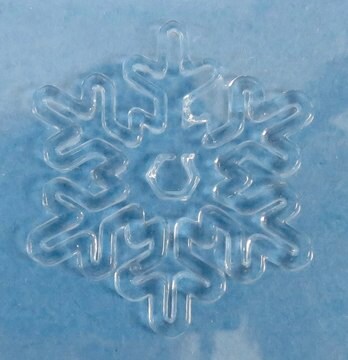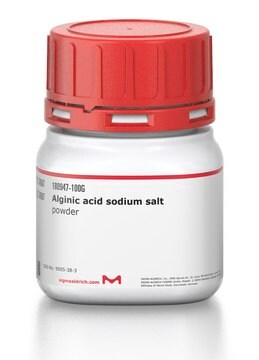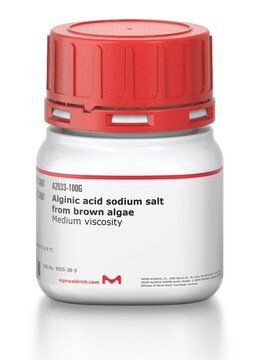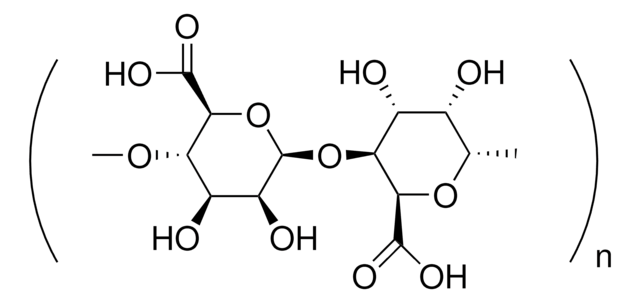推荐产品
描述
suitable for 3D bioprinting applications
形狀
gel form (Viscous)
雜質
≤5 CFU/g Bioburden (Fungal)
≤5 CFU/g Bioburden (Total Aerobic)
顏色
colorless to pale yellow
pH值
6.5-7.5
應用
3D bioprinting
儲存溫度
2-8°C
正在寻找类似产品? 访问 产品对比指南
一般說明
3D bioprinting is the printing of biocompatible materials, cells, growth factors, and the other supporting materials necessary to yield functional complex living tissues. 3D bioprinting has been used to generate several different types of tissue such as skin, bone, vascular grafts, and cartilage structures. Based upon the desired properties, different materials and formulations can be used to generate both hard and soft tissues. While several 3D printing methods exist, due to the sensitivity of the materials used, extrusion-based methods with bioinks are most commonly employed.
應用
Gelatin methacrylate-Alginate bioink formulation is derived from natural polymers - gelatin and alginate. Gelatin contains bioactive peptide sequences similar to native extracellular matrix which promotes integrin mediated cell adhesion and MMP sensitive enzymatic degradation which are essential for cellular functions such as migration, proliferation and differentiation. Alginate is a natural polysaccharide widely used in tissue engineering, serves as a viscosity enhancer in the bioink formulation. TissueFab®- GelAlg-Vis bioink formulation is optimized for 3D bioprinting of tissues and constructs using any extrusion based 3D bioprinter. TissueFab® - GelAlg-Vis bioink formulation can be used to bioprint cell-laden hydrogels in desired shape and can be crosslinked by a combination of chemical crosslinking and visible light mediated photocrosslinking for further culture and maturation of cells for tissue engineering and regenerative medicine applications. Gelatin methacrylate bioinks have been used for 3D bioprinting with high printing resolution, shape fidelity and cell viability. Gelatin methacrylate based bioinks have been used to bioprint osteogenic, chondrogenic, hepatic, adipogenic, vasculogenic, epithelial, endothelial, cardiac valve, skin, tumor and other tissues and constructs. Gelatin and alginate containing bioinks have been used for bioprinting of 3D constructs with various cell types including human mesenchymal stem cells (hMSC), embryonic stem cells (ESC), human umbilical vein endothelial cells (HUVEC), fibroblasts, cancer cells etc.
包裝
10 mL in glass bottle
法律資訊
TISSUEFAB is a registered trademark of Merck KGaA, Darmstadt, Germany
訊號詞
Warning
危險聲明
危險分類
Skin Sens. 1 - STOT RE 2
標靶器官
Liver,Upper respiratory tract
儲存類別代碼
10 - Combustible liquids
水污染物質分類(WGK)
WGK 3
閃點(°F)
Not applicable
閃點(°C)
Not applicable
其他客户在看
Weitao Jia et al.
Biomaterials, 106, 58-68 (2016-08-24)
Despite the significant technological advancement in tissue engineering, challenges still exist towards the development of complex and fully functional tissue constructs that mimic their natural counterparts. To address these challenges, bioprinting has emerged as an enabling technology to create highly
Marco Costantini et al.
Biofabrication, 8(3), 035002-035002 (2016-07-20)
In this work we demonstrate how to print 3D biomimetic hydrogel scaffolds for cartilage tissue engineering with high cell density (>10(7) cells ml(-1)), high cell viability (85 ÷ 90%) and high printing resolution (≈100 μm) through a two coaxial-needles system.
Liliang Ouyang et al.
Biofabrication, 8(3), 035020-035020 (2016-09-17)
3D cell printing is an emerging technology for fabricating complex cell-laden constructs with precise and pre-designed geometry, structure and composition to overcome the limitations of 2D cell culture and conventional tissue engineering scaffold technology. This technology enables spatial manipulation of
Thomas Billiet et al.
Biomaterials, 35(1), 49-62 (2013-10-12)
In the present study, we report on the combined efforts of material chemistry, engineering and biology as a systemic approach for the fabrication of high viability 3D printed macroporous gelatin methacrylamide constructs. First, we propose the use and optimization of
Y Shi et al.
Biomedical materials (Bristol, England), 13(3), 035008-035008 (2018-01-09)
Three-dimensional bioprinting is an emerging technology for fabricating living 3D constructs, and it has shown great promise in tissue engineering. Bioinks are scaffold materials mixed with cells used by 3D bioprinting to form a required cell-laden structure. In this paper
商品
Professor Shrike Zhang (Harvard Medical School, USA) discusses advances in 3D-bioprinted tissue models for in vitro drug testing, reviews bioink selections, and provides application examples of 3D bioprinting in tissue model biofabrication.
我们的科学家团队拥有各种研究领域经验,包括生命科学、材料科学、化学合成、色谱、分析及许多其他领域.
联系技术服务部门












